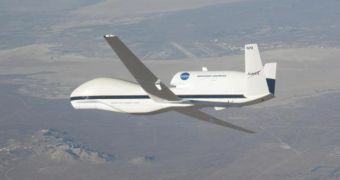For the first time in nearly ten years, NASA will be conducting its own study into the cause of tropical storms. AS part of this research effort, the American space agency will be deploying three aircrafts into the Gulf of Mexico, over the Atlantic Ocean, and in the Caribbean Sea. Each of these airplanes will fly to the very core of tropical storms, in a bid to determine what makes them turn into hurricanes, or calm down entirely. Scientists have been looking for the answer to this question for many years.
One of the three aircrafts to conduct the new study is a modified Global Hawk unmanned aerial vehicle (UAV), which has been converted from a reconnaissance/surveillance military asset to a scientific laboratory. The reason why this particular drone is so important to the research initiative is the fact that it carries the Lightning instrument Package (LIP), a collection of scientific instruments meant to detect and record lightning strikes inside a tropical storm. This will become possible because the Global Hawk can fly directly into the eye of such an atmospheric event.
With a whooping 20-hour non-stop flight capability, the drone is the main component of this field campaign, NASA officials say. Using the LIP for various investigations is nothing new, scientists say, but they add that this is the first time such a suite of instruments will be used in an unmanned aerial probe. According to NASA expert Ramesh Kakar, a member of the research team, the Global Hawk flights will allow researchers to gain a deeper understanding of how lightnings and tropical storms are interconnected, and if the former promotes or inhibits the development of the latter.
“The availability of the Global Hawk makes this a very exciting and unique experiment,” Kakar reveals. “We'll be able to see a storm in a way we've never seen it before. We'll see how the storm develops over the long term, and how lightning varies with all the other things going on inside a hurricane. It's the difference between a single photograph and a full-length movie. That's quite a paradigm shift,” adds Richard Blakeslee, the leader of the LIP study team. He is based at the NASA Marshall Space Flight Center, in Huntsville, Alabama.
“We can use lightning as a natural sensing tool to see into the heart of a storm. Lightning allows us to get at rain and other processes going on within a storm,” Blakeslee concludes, quoted by OurAmazingPlanet.

 14 DAY TRIAL //
14 DAY TRIAL //